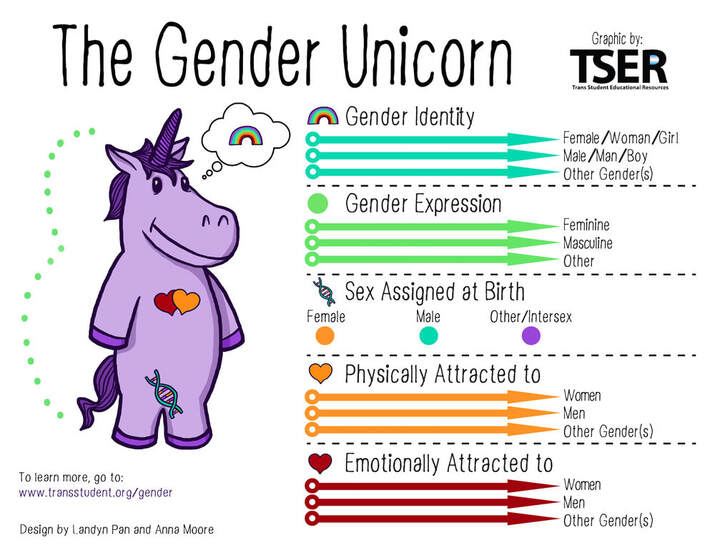|
|
 Trans Student Educational Resources (TSER) created an infographic, The Gender Unicorn, in 2014 to define the spectrums of gender and sexuality. The Gender Unicorn infographic illustrates four main concepts: gender identity, gender expression, sex assigned at birth, and attraction. Each category includes arrows to be used as sliding scales to help us recognize where we fall on each spectrum. Schools and universities often use it as a resource to help educate about gender diversity. Gender Identity: One’s internal sense of being male, female, neither of these, both, and/or other gender(s). Everyone has a gender identity, and for transgender individuals, their sex assigned at birth and their own internal sense of gender identity are not the same. Gender Expression/Presentation: This constitutes how we express or present our gender identity through clothing, hairstyles, make-up, body language, and voice. Every day, we express our thoughts and beliefs about our genders through appearance and behavior that could be classified as feminine, masculine, and/or non-conforming. Sex Assigned at Birth: The assignment and classification of people as male, female, intersex, or another sex based on a combination of anatomy, hormones, and chromosomes. (i.e AMAB - assigned male at birth) Physical Attraction: Sexual orientation. This is a part of our sexual identity that helps define our physical and sexual preferences for relationship partners. Asexuality is one sexual orientation that is used to describe someone who does not experience sexual attraction toward individuals of any gender. It is different from celibacy in that celibacy is the choice to refrain from engaging in sexual behaviors and does not comment on one’s sexual attraction. An asexual individual may choose to engage in sexual behaviors for various reasons even while not experiencing sexual attraction. Emotional Attraction: Romantic/emotional orientation. This describes an individual’s pattern of romantic attraction based on a person’s gender(s) regardless of one’s sexual orientation. For individuals who experience sexual attraction, their sexual orientation and romantic orientation are often in alignment (i.e. they experience sexual attraction toward individuals of the same gender(s) as the individuals they are interested in forming romantic relationships with). Differences between one’s sex assigned at birth and gender identity or expression may lead individuals to experience psychological distress and to be clinically diagnosed with gender dysphoria (Diamond, 2020). According to the DSM-5 TR, some transgender individuals will experience gender dysphoria, which refers to psychological distress that results from an incongruence between one’s sex assigned at birth and one’s gender identity. It can be resolved by altering one’s gender expression to coincide with gender identity, through changes in dress and appearance and, in some cases, by modifying the body through hormones or surgery. This process can be challenging, and unfortunately, gender-diverse youth have higher rates of anxiety, depression, and self-harm, and are disproportionately likely to commit suicide (Newcomb et al., 2020). By recognizing all aspects of our gender identity, we can help reduce stigma and misinformation around the conversation of gender. This is important because LGBTQ youth who live in a community that is accepting of LGBTQ people reported significantly lower rates of attempting suicide than those who do not (The Trevor Project, 2022). Resources:
References:
1 Comment
alina
10/27/2023 11:24:57 pm
Obtain great coupons at <a href=" https://coupondonor.com/coupons/devilsfilm
Reply
Leave a Reply. |
Categories
All
Archives
June 2024
|
